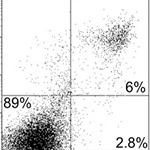The pseudopeptide HB-19 binds to cell surface nucleolin and inhibits angiogenesis
Main Article Content
Abstract
Background
Nucleolin is a protein over-expressed on the surface of tumor and endothelial cells. Recent studies have underlined the involvement of cell surface nucleolin in tumor growth and angiogenesis. This cell surface molecule serves as a receptor for various ligands implicated in pathophysiological processes such as growth factors, cell adhesion molecules like integrins, selectins or laminin-1, lipoproteins and viruses (HIV and coxsackie B). HB-19 is a synthetic multimeric pseudopeptide that binds cell surface expressed nucleolin and inhibits both tumor growth and angiogenesis.Methodology/principal findings
In the present work, we further investigated the biological actions of pseudopeptide HB-19 on HUVECs. In a previous work, we have shown that HB-19 inhibits the in vivoangiogenesis on the chicken embryo CAM assay. We now provide evidence that HB-19 inhibits the in vitroadhesion, migration and proliferation of HUVECs without inducing their apoptosis. The above biological actions seem to be regulated by SRC, ERK1/2, AKT and FAK kinases as we found that HB-19 inhibits their activation in HUVECs. Matrix metalloproteinases (MMPs) play crucial roles in tumor growth and angiogenesis, so we investigated the effect of HB-19 on the expression of MMP-2 and we found that HB-19 downregulates MMP-2 in HUVECs. Finally, down regulation of nucleolin using siRNA confirmed the implication of nucleolin in the biological actions of these peptides.
Conclusions/significance
Taken together, these results indicate that HB-19 could constitute an interesting tool for tumor therapy strategy, targeting cell surface nucleolin.Article Details
How to Cite
BIRMPAS, Charalampos et al.
The pseudopeptide HB-19 binds to cell surface nucleolin and inhibits angiogenesis.
Vascular Cell, [S.l.], v. 4, n. 1, p. 21, dec. 2012.
ISSN 2045-824X.
Available at: <https://vascularcell.com/index.php/vc/article/view/10.1186-2045-824X-4-21>. Date accessed: 20 jan. 2026.
doi: http://dx.doi.org/10.1186/2045-824X-4-21.
Section
Original Research

